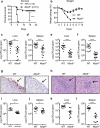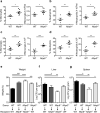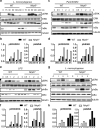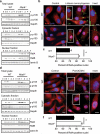NLRP6 negatively regulates innate immunity and host defence against bacterial pathogens
- PMID: 22763455
- PMCID: PMC3422416
- DOI: 10.1038/nature11250
NLRP6 negatively regulates innate immunity and host defence against bacterial pathogens
Abstract
Members of the intracellular nucleotide-binding and oligomerization domain (NOD)-like receptor (NLR) family contribute to immune responses through activation of nuclear factor-κB (NF-κB), type I interferon and inflammasome signalling. Mice lacking the NLR family member NLRP6 were recently shown to be susceptible to colitis and colorectal tumorigenesis, but the role of NLRP6 in microbial infections and the nature of the inflammatory signalling pathways regulated by NLRP6 remain unclear. Here we show that Nlrp6-deficient mice are highly resistant to infection with the bacterial pathogens Listeria monocytogenes, Salmonella typhimurium and Escherichia coli. Infected Nlrp6-deficient mice had increased numbers of monocytes and neutrophils in circulation, and NLRP6 signalling in both haematopoietic and radioresistant cells contributed to increased susceptibility. Nlrp6 deficiency enhanced activation of mitogen-activated protein kinase (MAPK) and the canonical NF-κB pathway after Toll-like receptor ligation, but not cytosolic NOD1/2 ligation, in vitro. Consequently, infected Nlrp6-deficient cells produced increased levels of NF-κB- and MAPK-dependent cytokines and chemokines. Thus, our results reveal NLRP6 as a negative regulator of inflammatory signalling, and demonstrate a role for this NLR in impeding clearance of both Gram-positive and -negative bacterial pathogens.
Figures




Similar articles
-
Nod2 and Rip2 contribute to innate immune responses in mouse neutrophils.Immunology. 2014 Oct;143(2):269-76. doi: 10.1111/imm.12307. Immunology. 2014. PMID: 24766550 Free PMC article.
-
The NLRP6 Inflammasome Recognizes Lipoteichoic Acid and Regulates Gram-Positive Pathogen Infection.Cell. 2018 Nov 29;175(6):1651-1664.e14. doi: 10.1016/j.cell.2018.09.047. Epub 2018 Nov 1. Cell. 2018. PMID: 30392956 Free PMC article.
-
The innate immune response to bacterial flagellin is mediated by Toll-like receptor 5.Nature. 2001 Apr 26;410(6832):1099-103. doi: 10.1038/35074106. Nature. 2001. PMID: 11323673
-
Genetic and Epigenetic Regulation of the Innate Immune Response to Gout.Immunol Invest. 2023 Apr;52(3):364-397. doi: 10.1080/08820139.2023.2168554. Epub 2023 Feb 6. Immunol Invest. 2023. PMID: 36745138 Review.
-
NLRP6: A Multifaceted Innate Immune Sensor.Trends Immunol. 2017 Apr;38(4):248-260. doi: 10.1016/j.it.2017.01.001. Epub 2017 Feb 15. Trends Immunol. 2017. PMID: 28214100 Review.
Cited by
-
Inflammasomes and host defenses against bacterial infections.Curr Opin Microbiol. 2013 Feb;16(1):23-31. doi: 10.1016/j.mib.2012.11.008. Epub 2013 Jan 11. Curr Opin Microbiol. 2013. PMID: 23318142 Free PMC article. Review.
-
Expression regulation and function of NLRC5.Protein Cell. 2013 Mar;4(3):168-75. doi: 10.1007/s13238-012-2109-3. Epub 2013 Mar 13. Protein Cell. 2013. PMID: 23483478 Free PMC article. Review.
-
ATP-Binding and Hydrolysis in Inflammasome Activation.Molecules. 2020 Oct 7;25(19):4572. doi: 10.3390/molecules25194572. Molecules. 2020. PMID: 33036374 Free PMC article. Review.
-
Inflammasomes in the gastrointestinal tract: infection, cancer and gut microbiota homeostasis.Nat Rev Gastroenterol Hepatol. 2018 Dec;15(12):721-737. doi: 10.1038/s41575-018-0054-1. Nat Rev Gastroenterol Hepatol. 2018. PMID: 30185915 Free PMC article. Review.
-
Hoodwinking the Big-Eater to Prosper: The Salmonella-Macrophage Paradigm.J Innate Immun. 2019;11(3):289-299. doi: 10.1159/000490953. Epub 2018 Jul 24. J Innate Immun. 2019. PMID: 30041182 Free PMC article. Review.
References
-
- Kanneganti TD, Lamkanfi M, Nunez G. Intracellular NOD-like receptors in host defense and disease. Immunity. 2007;27:549–559. - PubMed
Publication types
MeSH terms
Substances
Grants and funding
LinkOut - more resources
Full Text Sources
Other Literature Sources
Molecular Biology Databases

